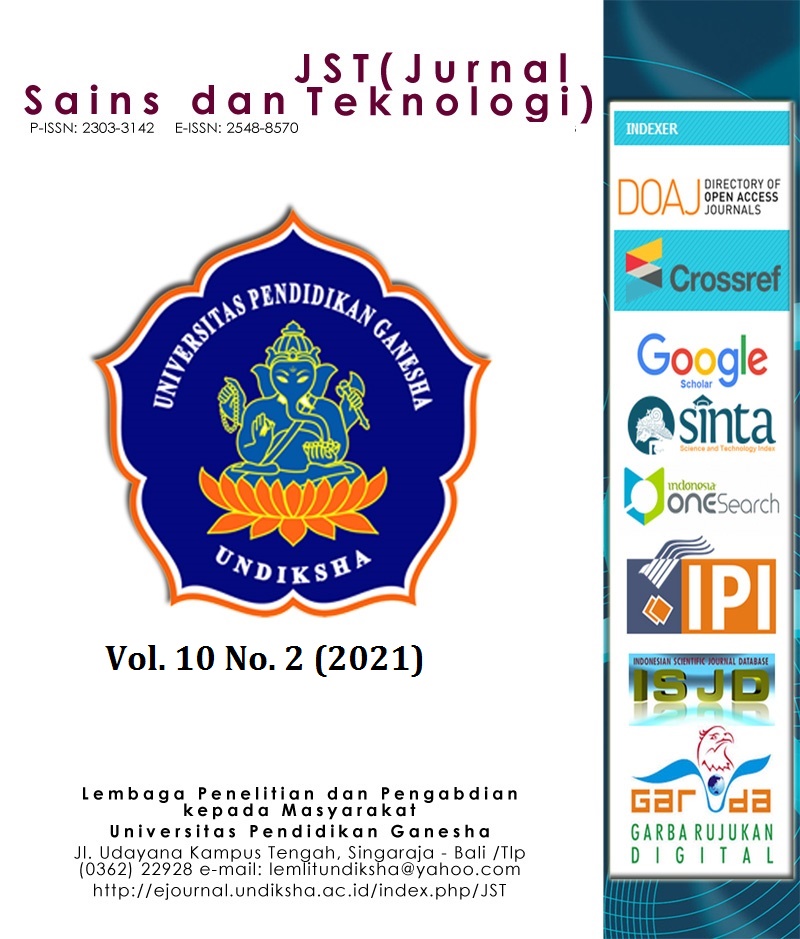PREDIKSI POTENSI SISWA PUTUS SEKOLAH AKIBAT PANDEMI COVID-19 MENGGUNAKAN ALGORITME K-NEAREST NEIGHBOR
DOI:
https://doi.org/10.23887/jstundiksha.v10i2.39151Keywords:
Prediction, Students, Algorithm, K-Nearest NeighborsAbstract
The implementation of the PSBB has an impact on all sectors, one of which is education, namely the threat of children dropping out of school. Dropouts explain that every student or student who leaves school or other educational institutions for any reason before finishing school without moving to another school. Early prediction must be done, to prevent many students dropping out of school. The dataset used in this study was taken from students in Junior High School (SMP) in Banyumas Regency. The method used in this study is the confusion matrix and 10-fold cross validation on the K-Nearest Neighbors (KNN) algorithm. The results obtained on the KNN algorithm in predicting the potential for dropout students are 87.4214%, with a precision value of 88.2%, recall 87.4% and F-Measure 87%. Then the results of the accuracy value on the KNN algorithm are categorized as Good ClassificationReferences
Bunker, R. P., & Thabtah, F. (2019). A machine learning framework for sport result prediction. Applied Computing and Informatics, 15(1), 27–33. https://doi.org/10.1016/j.aci.2017.09.005
Ernawati, S., & Wati, R. (2018). Penerapan Algoritma K-Nearest Neighbors Pada Analisis Sentimen Review Agen Travel. Jurnal Khatulistiwa Informatika, VI(1), 64–69. Retrieved from https://ejournal.bsi.ac.id/ejurnal/index.php/khatulistiwa/article/view/3802/2626.
Han, J., & Kamber, M. (2006). Data Mining Concepts, Model and Techniques 2nd Edition. San Fransisco: Elsevier.
Han, J., Kamber, M., & Pei, J. (2012). Data mining: concepts and techniques. Morgan Kaufmann (Third Edit, Vol. 5). USA: Elsevier. https://doi.org/10.1002/1521-3773(20010316)40:6<9823::AID-ANIE9823>3.3.CO;2-C
Hikmawan, S., Pardamean, A., & Khasanah, S. N. (2020). Sentimen Analisis Publik Terhadap Joko Widodo terhadap wabah Covid-19 menggunakan Metode Machine Learning. Jurnal Kajian Ilmiah, 20(2), 167–176. https://doi.org/10.31599/jki.v20i2.117
Mirza Yogy Kurniawan, & Muhammad Edya Rosadi. (2017). Optimasi Decision Tree Menggunakan Particle Swarm Optimization Pada Data Siswa Putus Sekolah. Jurnal Teknologi Informasi Universitas Lambung Mangkurat (JTIULM), 2(1), 7–14. https://doi.org/10.20527/jtiulm.v2i1.13
Nikmatun, I. A., & Waspada, I. (2019). Implementasi Data Mining untuk Klasifikasi Masa Studi Mahasiswa Menggunakan Algoritma K-Nearest Neighbor. Jurnal SIMETRIS, 10(2), 421–432.
Nur Rohim, Y., & Rezki, A. (2020). Kebijakan Pemberlakuan Lockdown Sebagai Antisipasi Penyebaran Corona Virus Covid-19. SALAM: Jurnal Sosial Dan Budaya Syar-I, 7(3). https://doi.org/10.15408/sjsbs.v7i3.15048
Sari, R. (2020). Analisis Sentimen Pada Review Objek Wisata Dunia Fantasi Menggunakan Algoritma K-Nearest Neighbor (K-Nn). EVOLUSI : Jurnal Sains Dan Manajemen, 8(1), 10–17. https://doi.org/10.31294/evolusi.v8i1.7371
Subarkah, P., Abdallah, M. M., & Hidayah, S. O. N. (2021). Komparasi Akurasi Algoritme CART Dan Neural Network Untuk Diagnosis Penyakit Diabetes Retinopathy. CogITo Smart Journal, 7(1), 121. https://doi.org/10.31154/cogito.v7i1.304.121-134
Tahyudin, I. (2020). Pengenalan Machine Learning Menggunakan Jupyter Notebook. Purwokerto: Zahira Media Publiser.
Downloads
Published
How to Cite
Issue
Section
License
Authors who publish with the Jurnal Sains dan Teknologi (JST) agree to the following terms:
- Authors retain copyright and grant the journal the right of first publication with the work simultaneously licensed under a Creative Commons Attribution License (CC BY-SA 4.0) that allows others to share the work with an acknowledgment of the work's authorship and initial publication in this journal.
- Authors are able to enter into separate, additional contractual arrangements for the non-exclusive distribution of the journal's published version of the work (e.g., post it to an institutional repository or publish it in a book), with an acknowledgment of its initial publication in this journal.
- Authors are permitted and encouraged to post their work online (e.g., in institutional repositories or on their website) prior to and during the submission process, as it can lead to productive exchanges, as well as earlier and greater citation of published work. (See The Effect of Open Access)
















